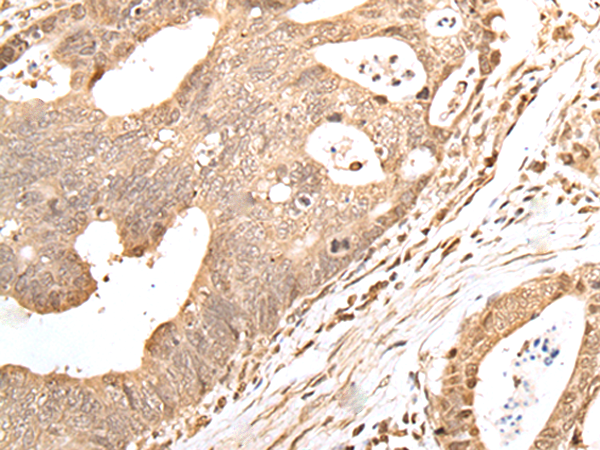

| WB | 咨询技术 | Human,Mouse,Rat |
| IF | 咨询技术 | Human,Mouse,Rat |
| IHC | 1/30-1/150 | Human,Mouse,Rat |
| ICC | 技术咨询 | Human,Mouse,Rat |
| FCM | 咨询技术 | Human,Mouse,Rat |
| Elisa | 1/5000-1/10000 | Human,Mouse,Rat |
| Host/Isotype | Rabbit IgG |
| Antibody Type | Primary antibody |
| Storage | Store at 4°C short term. Aliquot and store at -20°C long term. Avoid freeze/thaw cycles. |
| Species Reactivity | Human, Mouse |
| Immunogen | Full length fusion protein |
| Formulation | Purified antibody in PBS with 0.05% sodium azide and 50% glycerol. |
+ +
以下是3篇关于GRAP抗体的参考文献及其摘要概述:
---
1. **文献名称**:*"Structural and functional analysis of the GRB2‑related adaptor protein, GRAP"*
**作者**:S. Liu et al.
**期刊**:*Journal of Biological Chemistry* (2001)
**摘要**:本文解析了GRAP蛋白的SH2和SH3结构域结构,发现其通过与SOS1和SLP-76等信号分子相互作用,参与T细胞受体(TCR)下游信号传导。研究利用特异性抗体验证了GRAP在Jurkat细胞中的定位及功能。
---
2. **文献名称**:*"GRAP regulates TCR-induced actin cytoskeletal dynamics and immune synapse formation"*
**作者**:M. K. Jang et al.
**期刊**:*Molecular Immunology* (2003)
**摘要**:研究通过免疫共沉淀和Western blot(使用抗GRAP抗体)发现,GRAP缺失导致T细胞中Lat和PLCγ1磷酸化水平下降,并影响免疫突触形成,表明GRAP在T细胞活化中调控细胞骨架重组。
---
3. **文献名称**:*"Targeted disruption of GRAP gene in mice reveals its non-redundant role in T cell development"*
**作者**:T. Yokosuka et al.
**期刊**:*European Journal of Immunology* (2010)
**摘要**:通过构建GRAP基因敲除小鼠模型,结合抗体标记实验,证明GRAP在胸腺T细胞阳性选择中不可或缺,且其功能无法被同源蛋白GADS完全补偿。
---
**备注**:如需具体文献链接或补充内容,可进一步提供研究方向(如疾病模型、信号通路等)。
GRAP (GRB2-related adapter protein) is a cytoplasmic adapter protein involved in intracellular signal transduction pathways, particularly those mediated by receptor tyrosine kinases (RTKs). Belonging to the GRB2 family of adapter proteins, GRAP facilitates the formation of multi-protein signaling complexes by linking activated cell surface receptors to downstream effectors. It contains modular domains, including an N-terminal SH3 domain and a C-terminal SH2 domain, which enable interactions with phosphorylated tyrosine residues on receptors and other signaling molecules. GRAP plays a role in regulating immune responses, T-cell development, and neural signaling, with studies implicating its involvement in diseases such as cancer and autoimmune disorders.
GRAP antibodies are essential tools for studying the protein's expression, localization, and function. They are widely used in techniques like Western blotting, immunoprecipitation, and immunohistochemistry to detect GRAP in cell lysates, tissue samples, or experimental models. Research has shown that GRAP interacts with signaling pathways like Ras-MAPK and PI3K-AKT, influencing cell proliferation, differentiation, and apoptosis. Dysregulation of GRAP expression or activity has been observed in malignancies and inflammatory conditions, making it a potential biomarker or therapeutic target. These antibodies also aid in elucidating GRAP's crosstalk with related proteins like GRB2 and SOS1. advancing understanding of cellular communication networks.
×